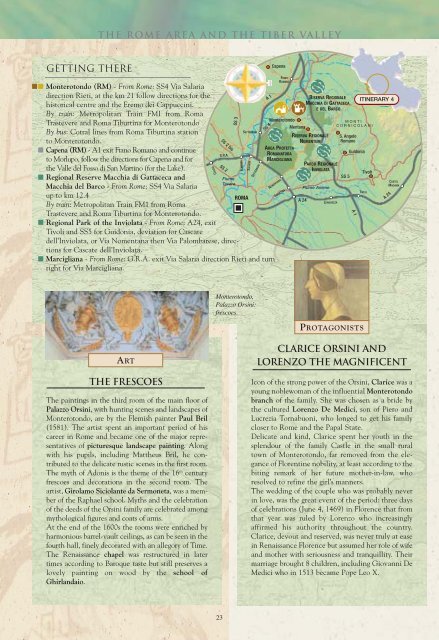Walking through time Walking through time - IBAM
Walking through time Walking through time - IBAM
Walking through time Walking through time - IBAM
You also want an ePaper? Increase the reach of your titles
YUMPU automatically turns print PDFs into web optimized ePapers that Google loves.
the rome area and the tiber valley<br />
getting there<br />
Monterotondo (RM) - From Rome: SS4 Via Salaria<br />
direction Rieti, at the km 21 follow directions for the<br />
historical centre and the Eremo dei Cappuccini.<br />
By train: Metropolitan Train FMI from Roma<br />
Trastevere and Roma Tiburtina for Monterotondo<br />
By bus: Cotral lines from Roma Tiburtina station<br />
to Monterotondo.<br />
Capena (RM) - A1 exit Fiano Romano and continue<br />
to Morlupo, follow the directions for Capena and for<br />
the Valle del Fosso di San Martino (for the Lake).<br />
Regional Reserve Macchia di Gattaceca and<br />
Macchia del Barco - From Rome: SS4 Via Salaria<br />
up to km 12.4<br />
By train: Metropolitan Train FM1 from Roma<br />
Trastevere and Roma Tiburtina for Monterotondo.<br />
Regional Park of the Inviolata - From Rome: A24, exit<br />
Tivoli and SS5 for Guidonia, deviation for Cascate<br />
dell’Inviolata, or Via Nomentana then Via Palombarese, directions<br />
for Cascate dell’Inviolata.<br />
Marcigliana - From Rome: G.R.A. exit Via Salaria direction Rieti and turn<br />
right for Via Marcigliana.<br />
CASSIA<br />
SS 2 bis<br />
G.R.A.<br />
SS 2<br />
SS 3<br />
Fiume<br />
Tevere<br />
FLAMINIA<br />
ROMA<br />
SETTEBAGNI<br />
SALARIA<br />
SETTEBAGNI<br />
A 1<br />
Monterotondo<br />
Mentana<br />
SS 4<br />
Capena<br />
AREA PROTETTA<br />
ROMANATURA<br />
MARCIGLIANA<br />
NOMENTANA<br />
FIANO<br />
ROMANO<br />
TIBURTINA<br />
RISERVA REGIONALE<br />
NOMENTUM<br />
A 24<br />
RISERVA REGIONALE<br />
MACCHIA DI GATTACECA<br />
E DEL BARCO<br />
PARCO REGIONALE<br />
INVIOLATA<br />
Fiume Aniene<br />
LUNGHEZZA<br />
MONTI<br />
CORNICOLANI<br />
S. Angelo<br />
Romano<br />
Guidonia<br />
SS 5<br />
A 1<br />
ITINERARY 4<br />
Tivoli<br />
TIVOLI<br />
CASTEL<br />
MADAMA<br />
A 24<br />
Monterotondo,<br />
Palazzo Orsini:<br />
frescoes.<br />
PROTAGONISTS<br />
ART<br />
the frescoes<br />
The paintings in the third room of the main floor of<br />
Palazzo Orsini, with hunting scenes and landscapes of<br />
Monterotondo, are by the Flemish painter Paul Bril<br />
(1581). The artist spent an important period of his<br />
career in Rome and became one of the major representatives<br />
of picturesque landscape painting. Along<br />
with his pupils, including Mattheus Bril, he contributed<br />
to the delicate rustic scenes in the first room.<br />
The myth of Adonis is the theme of the 16 th century<br />
frescoes and decorations in the second room. The<br />
artist, Girolamo Siciolante da Sermoneta, was a member<br />
of the Raphael school. Myths and the celebration<br />
of the deeds of the Orsini family are celebrated among<br />
mythological figures and coats of arms.<br />
At the end of the 1600s the rooms were enriched by<br />
harmonious barrel-vault ceilings, as can be seen in the<br />
fourth hall, finely decorated with an allegory of Time.<br />
The Renaissance chapel was restructured in later<br />
<strong>time</strong>s according to Baroque taste but still preserves a<br />
lovely painting on wood by the school of<br />
Ghirlandaio.<br />
CLARICE ORSINI and<br />
LORENZO the MAGNIFICent<br />
Icon of the strong power of the Orsini, Clarice was a<br />
young noblewoman of the influential Monterotondo<br />
branch of the family. She was chosen as a bride by<br />
the cultured Lorenzo De Medici, son of Piero and<br />
Lucrezia Tornabuoni, who longed to get his family<br />
closer to Rome and the Papal State.<br />
Delicate and kind, Clarice spent her youth in the<br />
splendour of the family Castle in the small rural<br />
town of Monterotondo, far removed from the elegance<br />
of Florentine nobility, at least according to the<br />
biting remark of her future mother-in-law, who<br />
resolved to refine the girl’s manners.<br />
The wedding of the couple who was probably never<br />
in love, was the great event of the period: three days<br />
of celebrations (June 4, 1469) in Florence that from<br />
that year was ruled by Lorenzo who increasingly<br />
affirmed his authority <strong>through</strong>out the country.<br />
Clarice, devout and reserved, was never truly at ease<br />
in Renaissance Florence but assumed her role of wife<br />
and mother with seriousness and tranquillity. Their<br />
marriage brought 8 children, including Giovanni De<br />
Medici who in 1513 became Pope Leo X.<br />
23
















